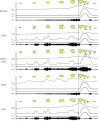TRP channels in lower urinary tract dysfunction
- PMID: 24895732
- PMCID: PMC4008998
- DOI: 10.1111/bph.12502
TRP channels in lower urinary tract dysfunction
Abstract
Lower urinary tract dysfunction (LUTd) represents a major healthcare problem. Although it is mostly not lethal, associated social disturbance, medical costs, loss of productivity and especially diminished quality of life should not be underestimated. Although more than 15% of people suffer from a form of LUTd to some extent, pathophysiology often remains obscure. In the past 20 years, transient receptor potential (TRP) channels have become increasingly important in this field of research. These intriguing ion channels are believed to be the main molecular sensors that generate bladder sensation. Therefore, they are intensely pursued as new drug targets for both curative and symptomatic treatment of different forms of LUTd. TRPV1 was the first of its class to be investigated. Actually, even before this channel was cloned, it had already been targeted in the bladder, with clinical trials of intravesical capsaicin instillations. Several other polymodally gated TRP channels, particularly TRPM8, TRPA1 and TRPV4, also appear to play a prominent role in bladder (patho)physiology. With this review, we provide a brief overview of current knowledge on the role of these TRP channels in LUTd and their potential as molecular targets for treatment.
Figures


Comment in
-
Re: TRP Channels in Lower Urinary Tract Dysfunction.J Urol. 2016 Feb;195(2):419. doi: 10.1016/j.juro.2015.10.111. Epub 2015 Oct 30. J Urol. 2016. PMID: 26852991 No abstract available.
References
-
- Abrams P, Cardozo L, Fall M, Griffiths D, Rosier P, Ulmsten U, et al. The standardisation of terminology in lower urinary tract function: report from the standardisation sub-committee of the International Continence Society. Urology. 2003;61:37–49. - PubMed
-
- Andersson K-E. Antimuscarinic mechanisms and the overactive detrusor: an update. J Urol. 2011;59:377–386. - PubMed
-
- Andrade EL, Ferreira J, André E, Calixto JB. Contractile mechanisms coupled to TRPA1 receptor activation in rat urinary bladder. Biochem Pharmacol. 2006;72:104–114. - PubMed
-
- Andrade EL, Forner S, Bento AF, Leite DFP, Dias MA, Leal PC, et al. TRPA1 receptor modulation attenuates bladder overactivity induced by spinal cord injury. Am J Physiol Renal Physiol. 2011;300:F1223–F1234. - PubMed
Publication types
MeSH terms
Substances
LinkOut - more resources
Full Text Sources
Other Literature Sources
Medical
Miscellaneous

